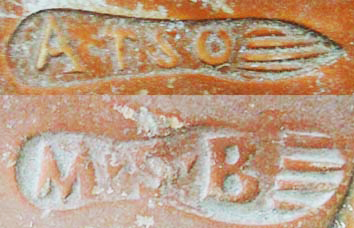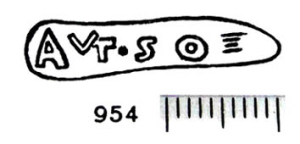By invitation of Smiljan Gluščević, in June 2014 I could investigate some Italian sigillata stamps in the depository of the Arheološki musej Zadar, originating from the harbour at Zaton.
A.T.SO in planta pedis
Within these, there are three identical stamps, well legible as A.T.SO in planta pedis. They are impressed on dishes Consp. 3.2 and derive from a north Italian production (TSTP).
Such a potter is not yet included in the OCK. There is listed only a single unattributable specimen as type 2858.152, coming from Budrio, on the floor of a plate, but described and drawn as AVT.SO. 1
Other examples, likewise on Consp. 3, were found at Iulia Concordia. 2
By comparing these stamps, apart from the three Croatian ones they do not seem to stem from the same die, because they all differ in the spacing of the letters, especially S and O. Whatever the V-shaped mark should mean or whether it is caused by a damaged die, is not yet determinable.
M.S.B in planta pedis
The second unknown potter, equally on a north Italian (TSTP) dish Consp. 3.2, is M.S.B in planta pedis. There is only one, but a very clear stamp within the material seen by me.
For that one I wasn’t able to find any parallel up to now. Presumably there will be a connection to the other Po Valley potters signing with the initials M.S., such as M.S.M, M.S.O, M.S.P, OCK 1757, 1758, 1760, respectively. (Other potters as M.S.FES OCK 1756 and M.S.SATV OCK 1761 definitively worked earlier than the aforementioned group.)
Has anybody already seen another specimen of such stamps and can tell me more about it?
Abbreviations:
- Consp.: E. Ettlinger et al., Conspectus formarum terrae sigillatae Italico modo confectae. (Bonn, Habelt, 1990).
- OCK: A. Oxé/H. Comfort/P.M. Kenrick, Corpus vasorum Arretinorum, second edition (Bonn, Habelt, 2000).
- TSTP: Terra sigillata tardo padana.







Sehr interessanter, schöner erster Beitrag im neuen Blog der Fautores. Leider kann ich nicht mit einem weiteren Stempel von A.T.SO oder M.S.B beitragen. Aber ich werde die Frage an andere Kollegen unter Hinweis auf diesen Blog-Beitrag weiterreichen.
From my FB Group I copy and paste this post from Gianluca Bottazzi, which can be a contribution to the discussion:
“Ho trovato edito un bollo M.S.R. in planta pedis da Ostellato (Ferrara). il confronto non è puntuale, ma non è presente nella lista indicata qui sopra. Caterina Cornelio Cassai nel 1997 propone con cautela per M.S.R. una connessione col più antico e già noto a Rimini M. Serius Romanus. E quindi mi chiedo: non sarà anche M.S.B. della “serie dei Serii”?
C. Cornelio Cassai, in Percorsi di Archeologia, a c. di F. Berti, Migliarino (Ferrara) 1997, p. 38, tav. IV,6. Per Marcus Serius Romanus, “attestato a Rimini” (Mazzeo 1983, p. 492).”
The vases with the stamp in Planta Pedis, were all produced in the city of Arezzo ( Arretium) Tuscany Italy, in the first and second centuries after Christ….then the Roman Army transported them to all the countries of the Roman Empire…and therefore they are found in other Italian areas as well as in France, Africa, Spain etc….but they are all manufactured by Arretium.
Thank you for your contribution!